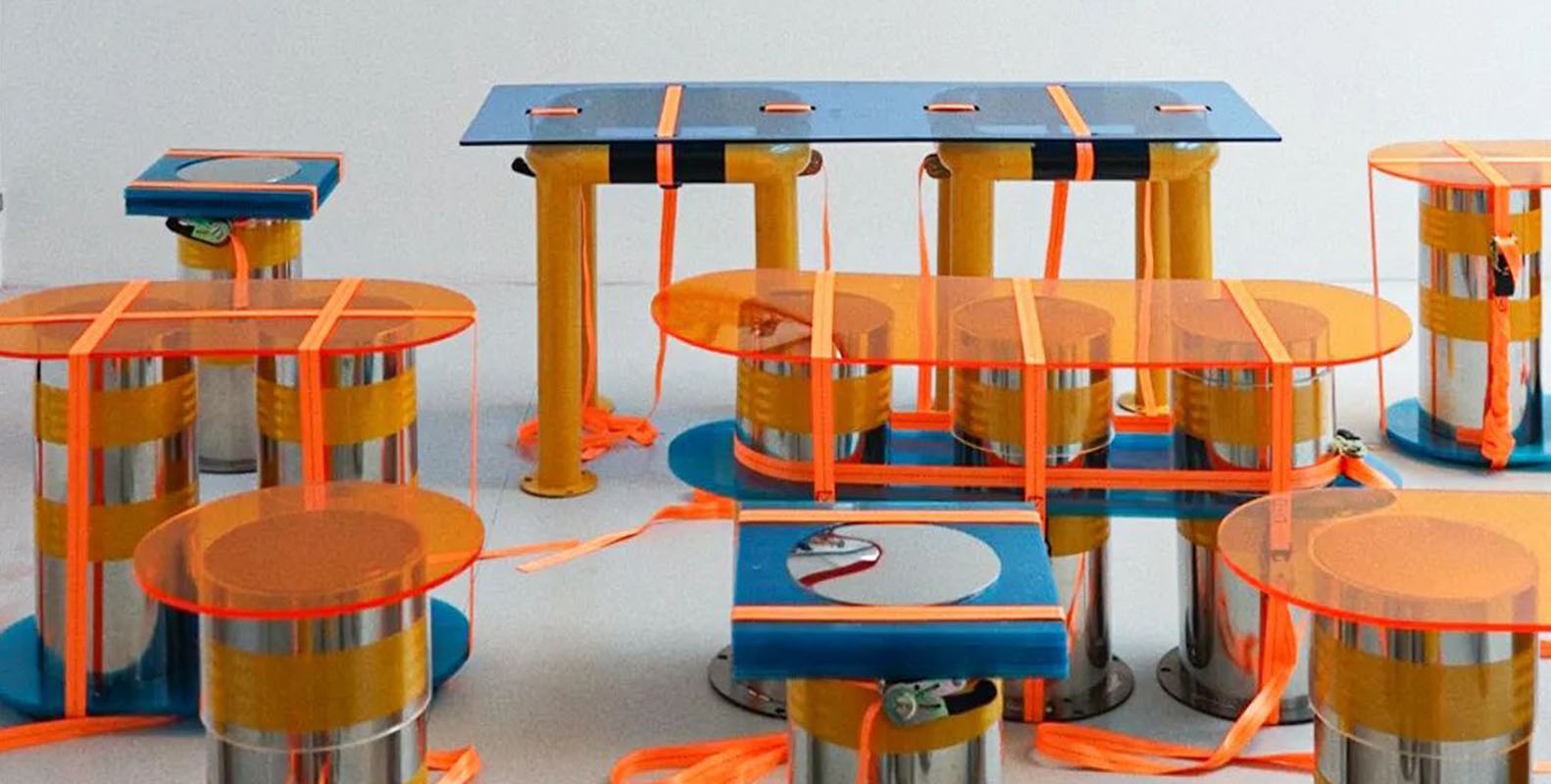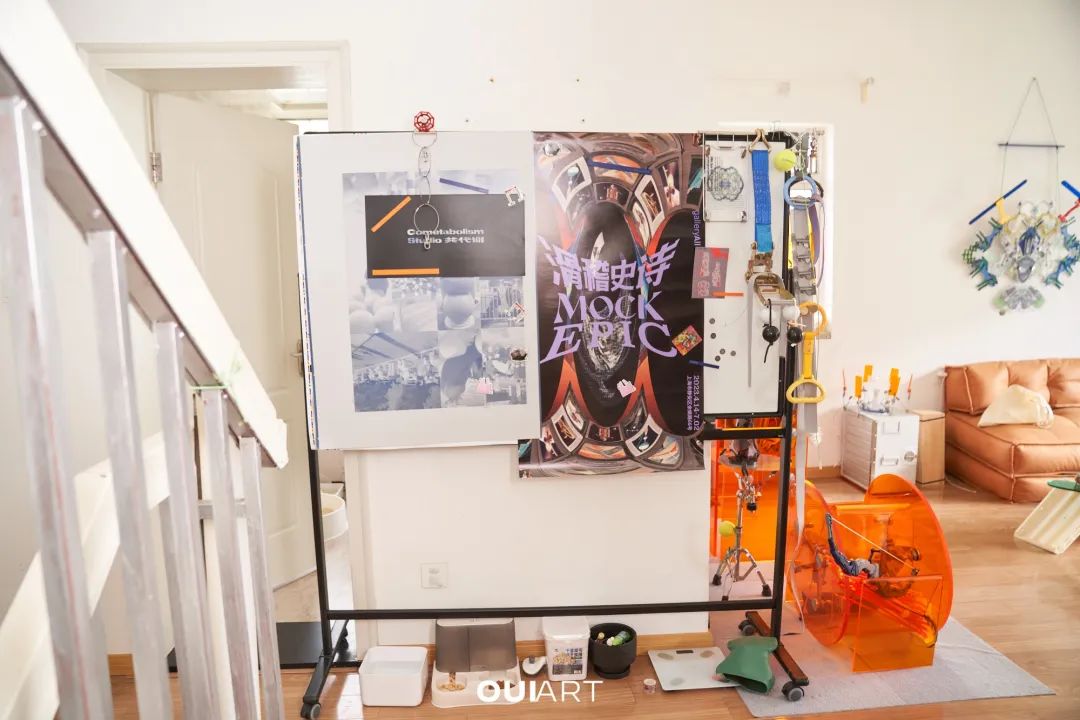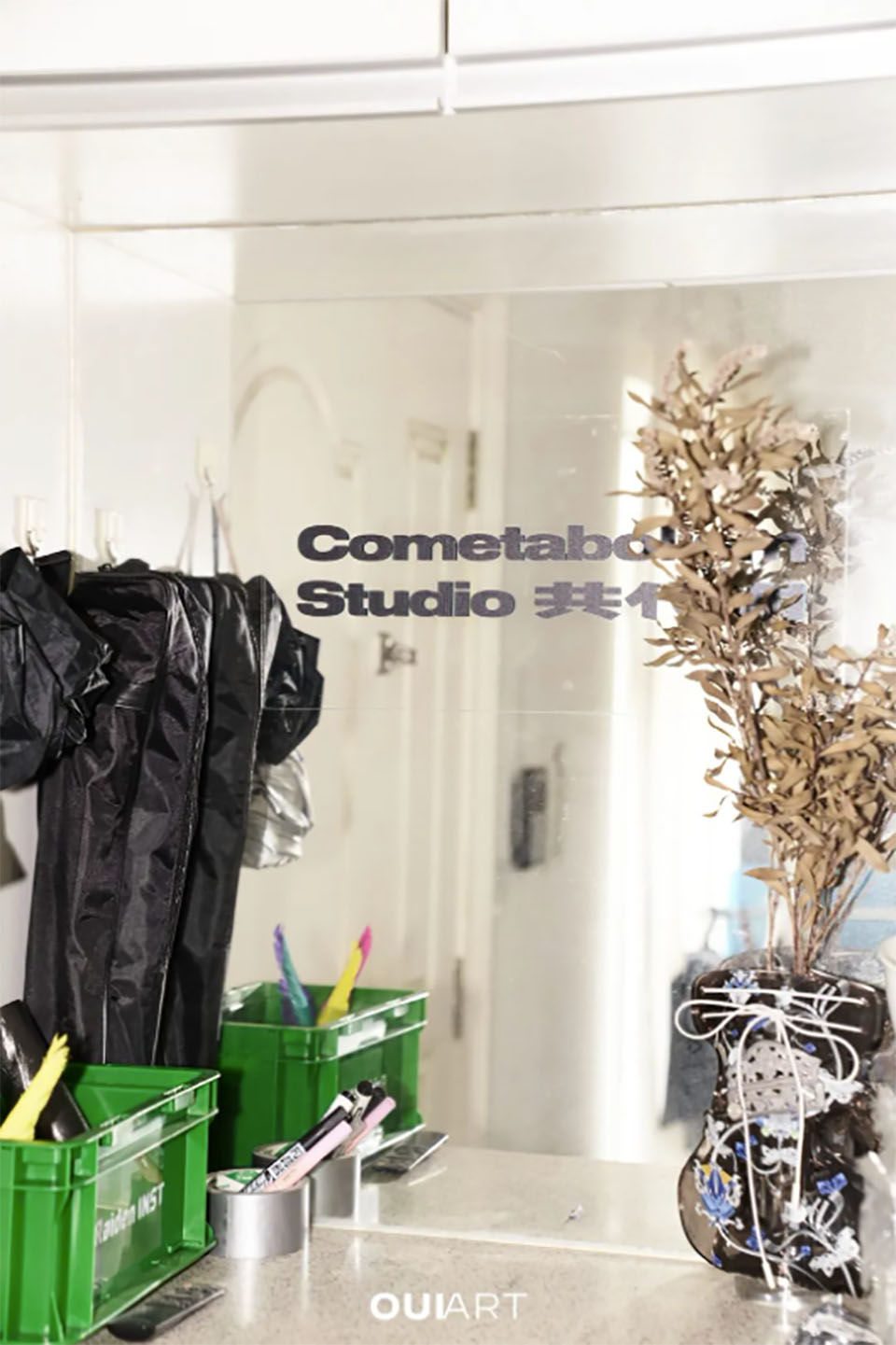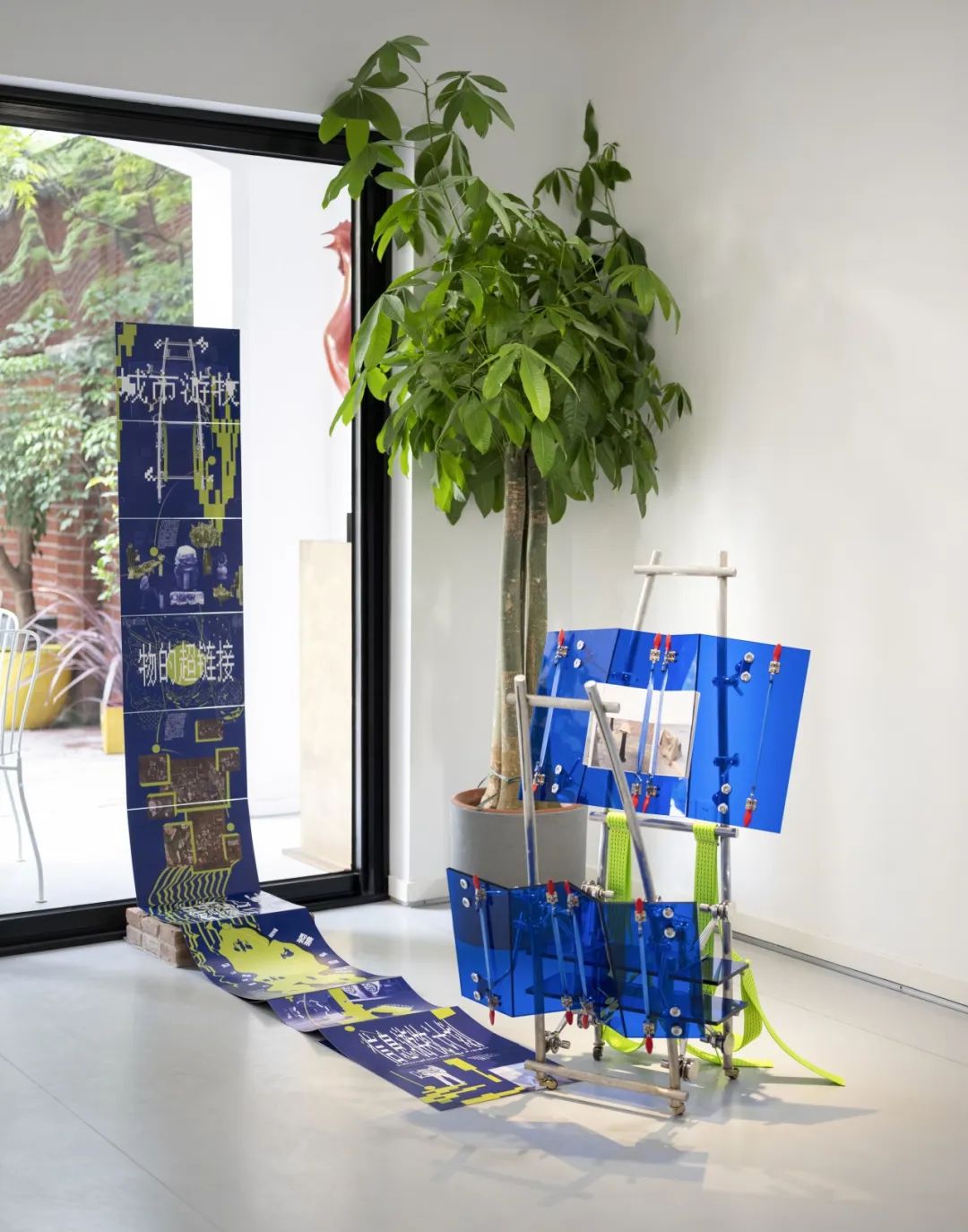
Cometabolism: Avant-Garde Practices in the Post-Industrial Era
In biology, "cometabolism" refers to a metabolic process in which microorganisms, while utilizing primary energy sources, simultaneously degrade specific organic compounds. The founders of Cometabolism Studio, Yafei Yang (later referred to as Yafei) and Ning Zhang, believe this concept is equally applicable to urban life and artistic creation. They focus on the byproducts of industrial production, exploring how to intervene in China's industrial processes to achieve resource reuse. They also observe how people in modern cities alter and repurpose the functions of objects—a form of "metabolism" in which everyday items are constantly redefined through use.
01 Interdisciplinary
The term "cometabolism" can be understood as a methodology. Can this be a stool? A transparent shelf? Or perhaps an artwork? In short, Cometabolism Studio's creations straddle the line between art and design, leaning more toward conceptual expression in the post-industrial era.
Both founders, Ning Zhang and Yafei Yang, have backgrounds in art and design. Ning Zhang studied interior design as an undergraduate before transitioning to pure art in graduate school, while Yafei began with oil painting and later studied furniture design. In 2020, their first year of operation, Cometabolism Studio won the "New Horizons" International Emerging Designer Gold Award. By 2021, Yafei and Ning Zhang had resigned from their jobs, rented a studio in Shanghai's Qingpu District, and embarked on a new creative and life journey. Their workflow involves conceptual discussions, sketching, and idea exchanges, followed by execution based on their respective strengths. Once designs are finalized, they collaborate with factories for production, handling the assembly themselves.
From the beginning of their collaboration until now, the two often had disputes, mainly regarding how to use a certain material, how to present it, and where to convey the content... However, these discussions often led to creative breakthroughs. Ning Zhang said, "When there were disputes, we would put aside our current tasks and have more detailed discussions. Even though sometimes we eventually found that our respective viewpoints and arguments were not on the same point, after the discussion, we would discover some 'breakthroughs' in the creation, and the works usually became better."
In 2023, Cometabolism Studio debuted their first solo exhibition, Mock Epic, in Shanghai, featuring around 20 large-scale installations primarily made of acrylic and metal. This exhibition solidified their reputation for material language and research. Their works, described as "a hybrid production between design and art"[1], invite viewers to reexamine overlooked details in daily life. By highlighting how people repurpose objects, they aim to artistically reactivate or blur the roles of industrial byproducts in space.
02 Maximizing Utility
The most well-known series of cometabolism, "Have a Seat", reflects the overlooked behaviors in the city - the roadblocks that were originally intended as barriers have become benches for passersby. In fact, this project originated from Ning Zhang's final project during his study in London: starting with a series of photographic images, it presents people's real lifestyles and forms interesting narrative relationships with related objects. And the objects themselves are not the idealized usage advocated by modernist design; their alternative functions prevail.
After collaborating with Asia and Africa, this "on-the-spot observation" was further developed. Starting from the observation in Beijing, the two hoped to capture and reflect this urban phenomenon through artistic creation. "For instance, we like to visit Beijing's parks and observe the pedestrians on the roadside... Even with public seats, many people still prefer to sit on the railings, elevated platforms and the edges of flower beds." The design inspiration for "Have a Seat" utilized stainless steel barriers combined with acrylic panels, changing the spatial relationship of the barriers in the city. This also suddenly added a sense of humor to the work, reaffirming the subtle connection between the work and the subtle connections that emerge in urban life on a subconscious level.
As early as when participating in the Talents " Design Shanghai Talents" section and creating Mixed public-private boundary collection in 2021, cometabolism began to reorganize the objects in public and private spaces, blurring their original functions and usage scenarios, breaking through the boundaries of common sense, and returning to the true state of the items, thereby triggering the audience's thinking and exploring more artistic possibilities.
And the subsequent Displacement series continued this concept, blending public and private spaces, exploring the static and dynamic nature of objects in space, and integrating the dimension of time into the works, creating new artistic works that adapt to the ever-changing reality.
For instance, "Information Nomad Project Nomad Bookshelf" aims to showcase the movement of items within the city. Through free collisions, it forms the surrounding scenes, thereby prompting viewers to reflect on the relationship between people and space in the information society. The framework of these practices seems to allow people to clearly see that the concept of "co-metabolism" attempts to, through its own creations, make viewers re-examine their lifestyles and cultural backgrounds, emphasizing the multiple usage methods of "objects". In their view, the function of an object should be left to the users to define, rather than being fixed by the creators.
03 Industrialization
Cometabolism Studio's works are instantly recognizable: transparent acrylic, fluorescent elements, and industrial fittings like cabinet hinges and hardware form their signature style.
They frequently repurpose recyclable or sustainable industrial materials. For instance, Transmission- Filtration visualizes the distortion and loss in information transmission. Ning Zhang explains, "We want viewers to feel how information deviates as it passes through different channels, creating a 'filtering' effect."
In the previous Mock Epic exhibition, the two used digital generation technology to create a series of artistic objects that explored the boundary between blurred reality and virtuality. Yafei mentioned that they enjoy observing the organization of industrial products and also pay attention to the information and data of industrial production. "We focus on the subtle connections between these items and their cultural significance, because in an era of highly developed information, people have difficulty distinguishing between reality and virtuality, and the boundaries of things have become increasingly blurred. For example, in Highway Odyssey, they 'used industrial components to reconstruct the common moving or stationary objects in urban spaces, imagining them superimposed in a new field with no definite function' [2]; while 'Multiple Premonitions' and' Half-Cube Suspension' used the real pool shape to create countertops, and the transparent blue acrylic board made people wonder if there was actually a reflection of water surface. "
Furthermore, they also extensively utilized materials and elements commonly found in industrial production. For instance, in the latest "Migration" - a symbiosis experimental project by P.art Lab, they created a space in the semi-open area of their outdoor corridor, inspired by the transfer and route maps of the subway, to explore the interactions and information exchange among people in the city. Using the colors white, blue, and yellow as the main presentation colors of the installation space, it immediately evokes the real subway scene, presenting the mobility and change of the artistic environment. Additionally, the two works presented in the "Migration" - a symbiosis experimental project explored the "flow of production information". "Mixing"《搅拌》 demonstrated the dynamic communication between people in digital production by suspending the office chair bases on the wall; "Slider" 《滑块》combined the slider verification mechanism of the Internet and presented it through a visual experiment with color blocks in a playful manner.
Analyzing their materials and compositions mirrors examining contemporary production relations. Bruno Latour, known for STS (Science, Technology, and Society) research, questioned modernity's boundaries in We Have Never Been Modern, proposing "hybrids" as both translation and purification. He argued that without reconfiguring our shared habitats, we risk losing the ability to integrate uncontrollable cultures and environments[3]. Science, thus, is not just about objects but also their social interactions.
In the post-industrial information age, how do we define judgment and cognition? Navigating between reality and virtuality offers a new lens to scrutinize ourselves and societal landscapes. By deconstructing, transforming, and resetting everyday objects with raw, industrial yet avant-garde methods, Cometabolism Studio’s ambiguous creations offer rational yet poetic responses to these questions.
Dialogue with Yafei and Ning Zhang

How do you view the gap between modern design and actual usage? How do you define your identities?

Modern design often has a clear purpose—like bollards for blocking roads. But people use them as stools or footrests. Sofas are for sitting, yet most pile clothes, becoming shelves. These unintended uses fascinate us.

We approach these behaviors neutrally, exploring future human lifestyles. They reflect real life, not idealized modernist functions. Our work highlights these overlooked actions.

How did your creative philosophy shift from functionality to art-design fusion?

In fact, at the very beginning, we didn't limit our design or creative scope either. Instead, we felt that a purely functional orientation restricted our creative space. Our works are not merely functional items. Many people ask us how we define our identity - as artists or designers? Actually, either is fine. This "not being defined" actually gives us more space to do more things. In fact, we hope our works can bring a new perspective to help people view life and objects differently.

We all have studied pure art and design. This background enables us to explore different possibilities more freely in our creations. We hope that through our works, we can break the boundaries of traditional design and art, and transform these personal and unique perspectives into powerful artistic expressions.

How do you balance sustainability with production logic in your eco-conscious era?

In our creations, we will incorporate mass-produced items, reuse them, and reintroduce them into social life. This in itself is a form of recycling.

You tend to use highly saturated colors in your creations. Could you tell me how and when you first became interested in the application and visual effects of such colors in daily life?

We often use industrial colors because they inherently possess a genuine and direct visual impact. We do not deliberately choose popular colors; instead, we prefer to use those basic and common industrial colors, such as the colors of cleaning staff uniforms. These colors are not only cost-effective but also are warning colors that can draw the attention of viewers.

We pay more attention to the colors of industrial products themselves, such as the yellow and black warning coating on highway fences and the yellow reflective tape on road barriers. Sometimes it's not that we deliberately choose such colors, but they exist in the industrial process naturally. It's just that we happened to use them.

How do materials and structure interact in your work?

We use materials such as stainless steel to construct the main body of the work because they can give a sense of strength and stability. Moreover, stainless steel itself is also a symbol of modern mass production.

We might use transparent acrylic to achieve a light and transparent effect, which would better showcase the internal structure of the work and emphasize the industrial components within. The structure is not merely a physical support; it is more about the inherent logic of our work: a reflection on the production methods of the post-industrial era, and an approach to intervention and interaction through the lens of an artist and designer.

Producer:Tiffany Liu
Editor:Simone Chen
Interview, Writer:陈元
Photographer:罗浩 @HAAALO COMPANY
Stylist:pepe
Makeup:小王子
Designer:Nina
The artwork image is provided by the artist himself








